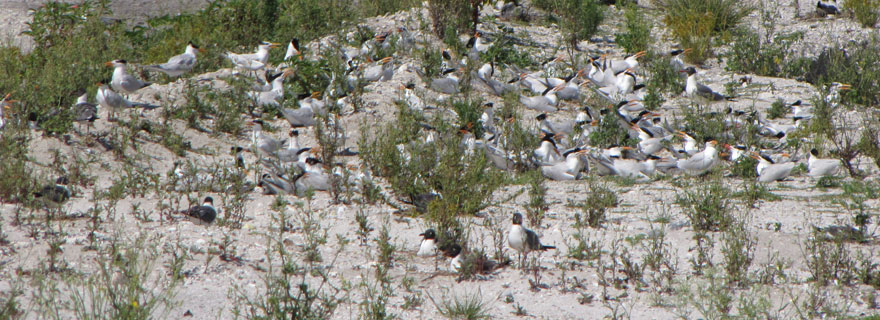Top: A colony of royal terns nests on a dredged material management area in Hillsborough Bay. Photo courtesy Audubon Florida.
Running the state’s busiest port and protecting some of the world’s most important bird nesting areas may seem like totally separate goals but that’s what the Migratory Bird Protection Implementation Committee (MBPIC) does every bird nesting season.
“Harbor management operations require dredging channel and berth depths appropriate for safe ship traffic,” says Ann Paul, Tampa Bay regional coordinator for Audubon Florida. “At the same time, storing the dredged material creates habitat that attracts beach-nesting birds. The challenge comes when those nesting birds – including many endangered or threatened species – need peace to successfully fledge their young.”

Because natural beach habitat is increasingly unavailable to these birds, Port Tampa Bay’s dredge material disposal islands have become favored nesting sites, recognized internationally as “globally significant” for birds. MBPIC is a unique partnership bringing together staff from Port Tampa Bay, the U.S. Army Corps of Engineers, the U.S. Fish and Wildlife Service, the Florida Fish and Wildlife Conservation Commission, with Audubon Florida participating in an advisory capacity. Other members include the Florida Department of Environmental Protection, the Environmental Protection Commission of Hillsborough County, Tampa Bay Estuary Program, and staff from dredging and construction companies.
“The USFWS recognizes the importance of these nesting sites and works with our partners on the MBPIC to minimize potential impacts and maximize nesting success,” says Cindy Fury, wildlife biologist for the Florida/Caribbean migratory bird field office.
Those partnerships are critical to the success of the committee, adds Bruce Laurion, PTB’s vice president of engineering. “We meet every year before nesting season begins to review any events that might be going on and develop a plan to protect the birds. If something comes up, we all know who to talk to, whether it’s someone at the port, the contractor, Audubon or FWC.”
While the port has more leeway in scheduling dredging events and generally avoids using the islands during summer nesting season, the USACE must meet strict timelines for spending federal dollars and dredges shipping channels year-round. The plan, which is reviewed annually, includes:
- PTB and USACE, as well as their contractors, outline dredge or construction plans and coordinate with the MBPIC to develop a project site-specific bird protection plan to avoid impacts to nesting birds during work. Bird deterrence measures are reviewed and evaluations of their effectiveness are included in the post-nesting season reports and meeting discussions.
- Audubon or other authorized bird experts conduct pre-construction in-service training for all dredge and construction contractor staff.
- Daily bird monitoring is conducted in areas of construction or dredging activity during the nesting season by qualified personnel to alert contractors before nesting birds are impacted.
- Access is limited to delineated work areas to reduce impacts to nesting birds.
- PTB, USACE, contractor staff, and Audubon coordinate through weekly communication on activities during the bird nesting season.
- Bird nesting season summary reports are prepared by the contractors at the end of the project or the bird nesting season.
“Dikes around the island have been raised to expand capacity, so this is the first time in two years that USACE has actually been able to use them for dredged materials,” Paul said.
The expansion is expected to handle maintenance dredging for up to 20 years, Laurion adds.
Dredged materials bring both benefits and challenges to region
With an average depth of just 12 feet, the ports lining Tampa Bay’s shores depend upon dredging to keep operating. Year-in and year-out, more than 2 million cubic yards of material is removed from the 80 miles of shipping channels and berths that allow ships to dock. Most of that material is disposed of on two islands located near the mouth of the Alafia River because it’s too silty to use in other areas.
Dredging for new berths or wider channels, however, creates material that can be used to bolster shorelines or provide other environmental benefits, including filling dredge holes to depths where seagrasses can grow.
“Tampa Bay is well ahead of the curve on beneficial uses for dredged material,” notes Jackie Keiser, who coordinates Regional Sediment Management Plans for the U.S. Army Corps of Engineers from its Jacksonville office. “But even with all that’s been accomplished, there is still potential for more.”
The USACE has begun a feasibility study on expanding Port Manatee which would create up to 2 million yards of new dredged material and several other dredging projects are in the planning stages. A committee formed earlier this year, including staff from the USACE and local stakeholders, is working on a comprehensive sediment management plan that would look at ways to use that material most effectively.
It will also look at innovative uses of dredged materials nationally, including Jacksonville, New Orleans, Mobile, and Charleston, S.C.
For more information, contact Gary Raulerson at the Tampa Bay Estuary Program, graulerson@tbep.org.
